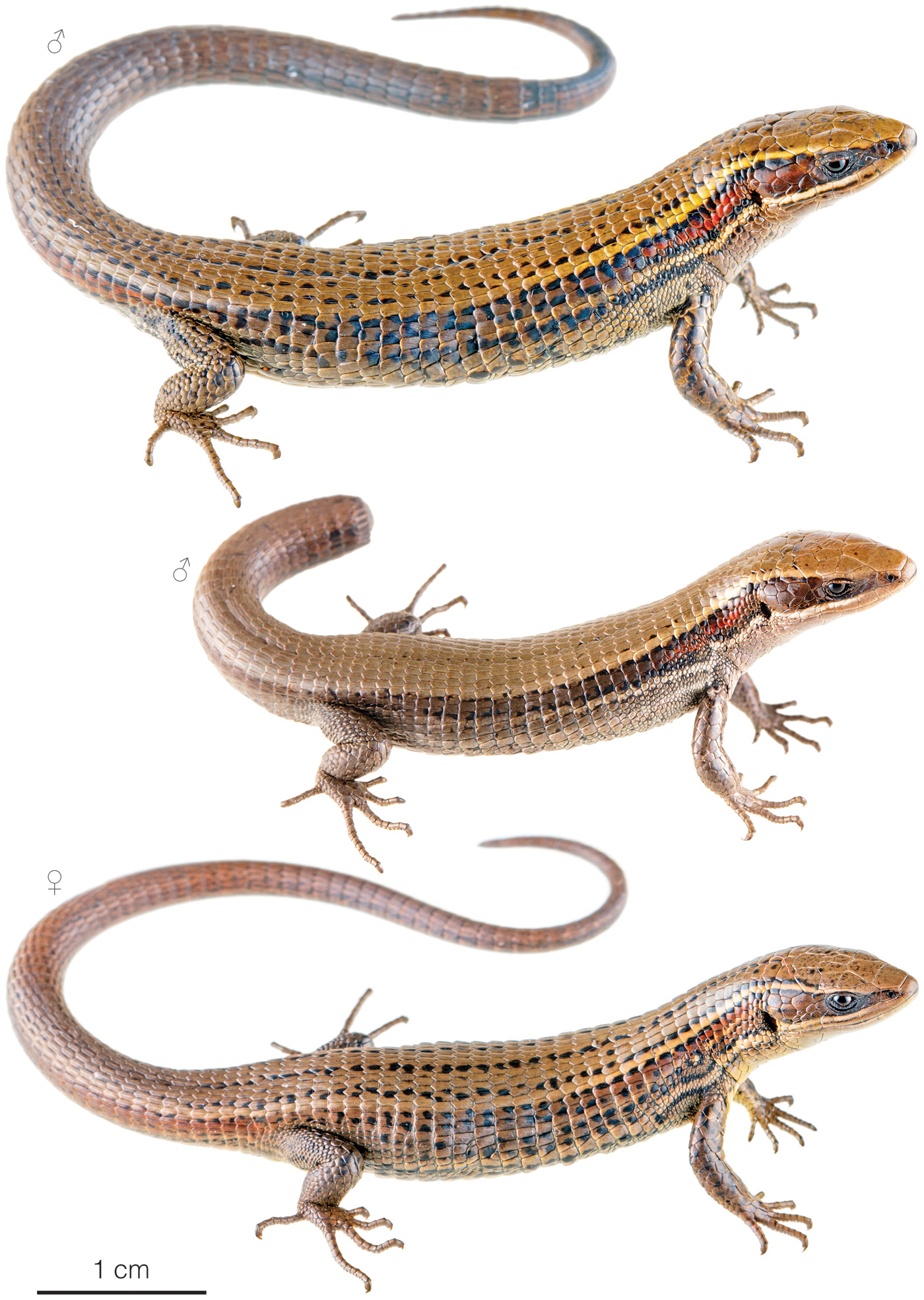Published August 17, 2021. Updated November 24, 2023. Open access. Peer-reviewed. | Purchase book ❯ |
Haunted Sticklizard (Pholidobolus fascinatus)
Reptiles of Ecuador | Sauria | Gymnophthalmidae | Pholidobolus fascinatus
English common name: Haunted Sticklizard.
Spanish common names: Cuilanpalo encantado, Cuilán encantado.
Recognition: ♂♂ 16.5 cmMaximum distance from the snout to the tip of the tail. Snout–vent length=5.2 cm. ♀♀ 15.3 cmMaximum distance from the snout to the tip of the tail. Snout–vent length=4.8 cm..1 Sticklizards differ from other lizards by having short but well-developed limbs, overlapping striated sub-hexagonal dorsal scales, and a brownish dorsal pattern with longitudinal stripes.2,3 The presence of six-sided finely wrinkled dorsal scales distinguishes Pholidobolus from other co-occurring small brownish lizards such as those in the genera Alopoglossus, Anadia, Andinosaura, Macropholidus, and Riama.4 The Haunted Sticklizard (P. fascinatus) is unique among its congeners in lacking widened medial scales on collar (posterior row of gulars) and by having a loreal scale frequently in contact with the supralabials (loreal scale, if present, not in contact with supralabials in the other sticklizard species).1 Males of P. fascinatus usually have a reddish lateral stripe on the anterior third of the flanks as well as a contrasting underside coloration, whereas females have more opaque colors.1

Figure 1: Individuals of Pholidobolus fascinatus from Lake Chillacocha, El Oro province, Ecuador.
Natural history: Pholidobolus dolichoderes is a rarely seen lizard that inhabits an area of seasonally dry montane shrubland, humid páramo, and montane forest with little human intervention.1,5 Haunted Sticklizards have been found active at ground level between 2:00 pm and 5:00 pm or dormant under stones or decaying logs at night.1,5 There are records of communal nests with up to 41 eggs, with adult specimens usually found near the nest.1
Conservation: Data Deficient There is inadequate information to make an assessment of extinction risk..1 Pholidobolus fascinatus was proposed to be included in this category because there is not enough information to make an accurate assessment of the species’ conservation status. The available sampling, though suggesting low abundances, is insufficient to estimate the population size.1 This species is known only from the surroundings of Lake Chillacocha, so more information is necessary to place it in a conservation category.1 So far, Haunted Sticklizards have not been reported in any protected area. The most important threat facing the species is the destruction of the páramo due encroaching human activities such as agriculture, cattle grazing, wildfires, and the replacement of native vegetation with eucalyptus and pine trees.
Distribution: Pholidobolus fascinatus is endemic to the Cordillera de Chilla, a mountain range in southwestern Ecuador. Currently, the species is known only from around Lake Chillacocha, El Oro province, at elevations between 3348 and 3382 m (Fig. 2).

Figure 2: Distribution of Pholidobolus fascinatus in Ecuador. The star corresponds to the type locality: Lake Chillacocha, El Oro province.
Etymology: The generic name Pholidobolus comes from the Greek words pholidos (=scale) and bolos (=lump),6 and probably refers to the imbricated or mounted scales. The specific epithet fascinatus is a Latin word meaning “enchanted,” in allusion to Lake Chillacocha, also known as the Enchanted Lake.1
See it in the wild: Haunted Sticklizards are not easy to find. The only place where they have been reported is around Lake Chillacocha and the species is not common there. The best way to find these lizards is to search under rocks and logs during the day for prolonged periods of time.
Author: Amanda QuezadaaAffiliation: Tropical Herping (TH), Quito, Ecuador.,bAffiliation: Laboratorio de Herpetología, Universidad del Azuay, Cuenca, Ecuador.
Editor: Alejandro ArteagacAffiliation: Fundación Khamai, Reserva Arlequín, Ecoruta Paseo del Quinde km 56, Santa Rosa de Mindo, Pichincha 171202, Ecuador.
Academic reviewer: Jeffrey D CamperdAffiliation: Department of Biology, Francis Marion University, Florence, USA.
Photographer: Jose VieiraaAffiliation: Tropical Herping (TH), Quito, Ecuador.,eAffiliation: ExSitu, Quito, Ecuador.
How to cite? Quezada A (2023) Haunted Sticklizard (Pholidobolus fascinatus). In: Arteaga A, Bustamante L, Vieira J (Eds) Reptiles of Ecuador: Life in the middle of the world. Available from: www.reptilesofecuador.com. DOI: 10.47051/ALRX1271
Literature cited:
- Parra V, Sales Nunes PM, Torres-Carvajal O (2020) Systematics of Pholidobolus lizards (Squamata, Gymnophthalmidae) from southern Ecuador, with descriptions of four new species. ZooKeys 954: 109–156. DOI: 10.3897/zookeys.954.50667
- Montanucci RR (1973) Systematics and evolution of the Andean lizard genus Pholidobolus (Sauria: Teiidae). Miscellaneous Publications of the Museum of Natural History, University of Kansas 59: 1–52.
- Torres-Carvajal O, Venegas P, Lobos SE, Mafla-Endara P, Sales Nunes PM (2014) A new species of Pholidobolus (Squamata: Gymnophthalmidae) from the Andes of southern Ecuador. Amphibian & Reptile Conservation 8: 76–88.
- Peters JA, Donoso-Barros R (1970) Catalogue of the Neotropical Squamata: part II, lizards and amphisbaenians. Bulletin of the United States National Museum, Washington, D.C., 293 pp.
- Field notes, Reptiles of Ecuador book project.
- Brown RW (1956) Composition of scientific words. Smithsonian Books, Washington D.C., 882 pp.